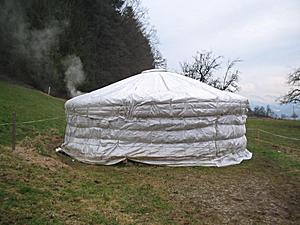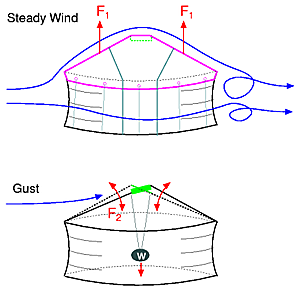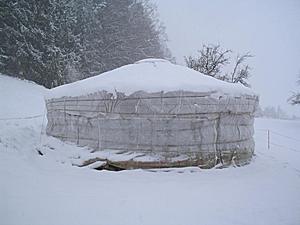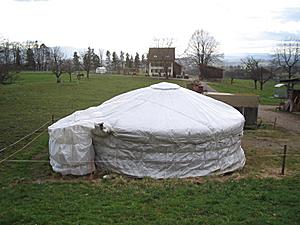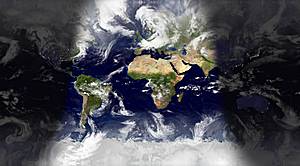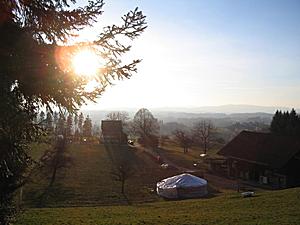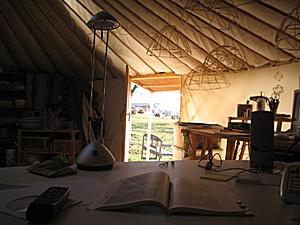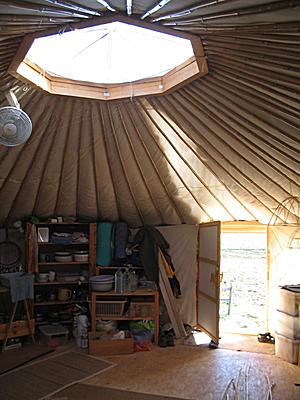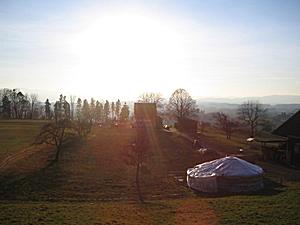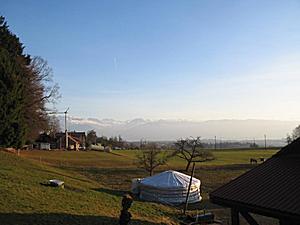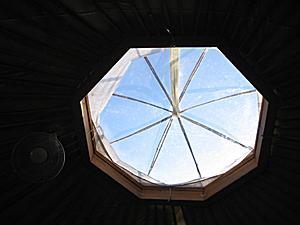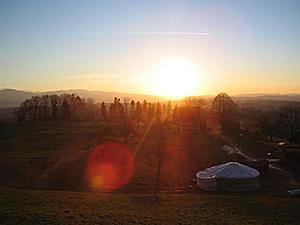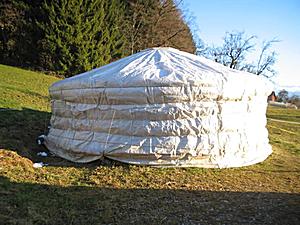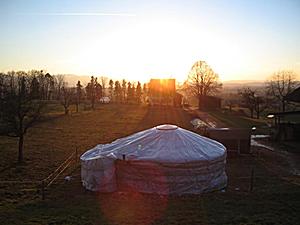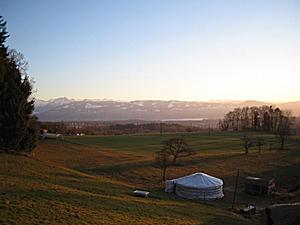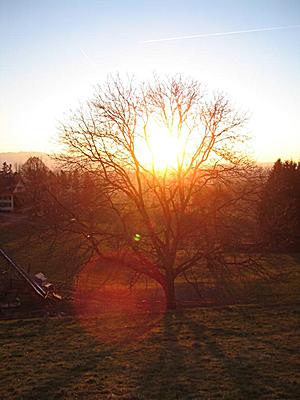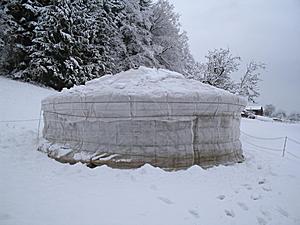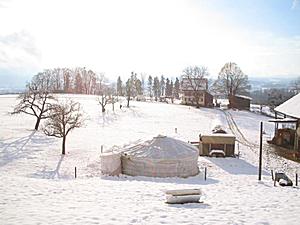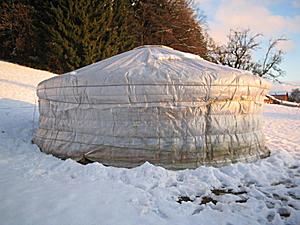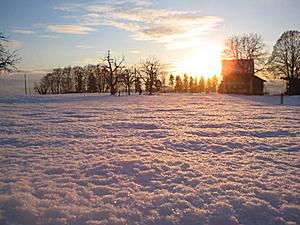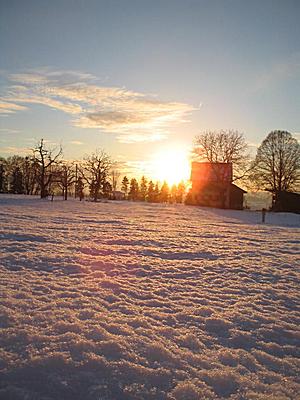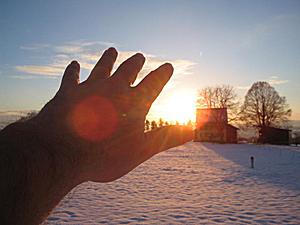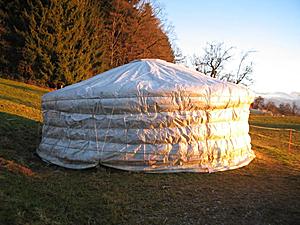
|
Page << Prev | 1 | 2 | 3 | 4 | 5 | 6 | 7 | 8 | 9 | 10 | 11 | 12 | 13 | 14 | 15 | 16 | 17 | 18 | 19 | 20 | 21 | Next >> Yurt / Ger Diarywritten by Rene K. Mueller, Copyright (c) 2005, 2006, 2007, 2008, 2009, last updated Sat, January 3, 2015 10. 3. 2008: Milder, Snow Gone
Storm Aftermath
The force F1 in the illustration is the same force occuring on an airplane wing, the wind goes faster over the roof, creates a lower airpressure, and pulls the rain cover up. Usually the ropes around the yurt a bit below the wall roof junction cannot keep the roof cover sufficiently, but using cords to pull the roof cover down on the ground does it usually - or ropes going over the entire roof. Usually behind the yurt some whirls occur, I have noticed it quite well at heavy winds the smoke from the stove whirling behind the yurt, and even sometimes forward against main wind direction, but it's also because I'm close on a slope of a mountain, where the winds create a whirl on the entire slope along with the nearby forest. In a way, it showed at strong winds the nearby environment can create large whirls as well.
The F2 indicates a swinging force of a gust, pushing down the front roof, and then releasing it and counter balance by going up - there the risk of roof poles falling off their holes in the crown-wheel.
The mentioned weight pulling down the crown-wheel limits these swings - I would not recommend to fasten it with a cord direct on the ground, but rather have a floating weight able to give in.
5. 3. 2008: Little Snow, Temperature Drop
I noticed the grass, flowers leafs and bush buds has been growing the last two weeks. Some willow cuts I have been putting into a vase has been growing, creating buds, leafs, and even blooms after 3-4 weeks within the yurt aside of the stove.
I have been skinning larger willow rods for some construction for a larger skylight of a 2m diameter crown-wheel, and the cut away twigs are those I put into a vase - handling the 4-25°C temperature within the yurt quite well.
While researching a bit about willow, I found out the skin can be used as medicine - which later was synthetic replicated and then known as "Aspirin" (see Wikipedia: Willow 2. 3. 2008: Fixing Skylight
The newer skylight has strong frame, in particular at the corners - so I taped the broken PVC a bit, and covered it with a double layer bubblewrap, and keep the older skylight for replacement. The newer skylight actually looks much older than the old skylight - as I didn't use the old skylight that much. The light inside the yurt is still bright, but I can't see the clouds, sun or the stars anymore due the bubblewrap. I'm thinking of another skylight approach without PVC which breaks too quickly when exposed to UV and then under physical stress like falling on the ground while fixed on a frame - a rather softer material would be good, still bendable and clear as PVC. I also had to replace a few cords of the attached room and readjust the rain covers - now everything is set again. Last night we had another more tame storm passing by - it kept me awake a bit.
Storm "Emma" seemed to be even stronger than "Kyrill" back in 2007/01 with over 220km/h in the alpes, in particulary it hit Germany and Czech Republic.
In Switzerland where I reside it was up to 177km/h according various news sources.
1. 3. 2008: Winter Storm, Skylight Damaged
I knew there would be a storm or even hurricane approaching Germany, and partially also hit Switzerland, but I hoped I would be early enough back to fasten everything which is loose, and I sort of was able to do so - would I have stayed in the yurt during the storm likely I would have fasten the cover more and roof ropes hold the roof in shape. Afterwards you are wiser. I have dealt now with 1-2 strong storms the past two years, and I thought the yurt will withstand that past storm, it did - but I could have done better preparation especially being away. I'm also still looking for a good solution to fasten the cover tightly and still have snow slide - usually when winter storms occur, a major temperature change is happening, e.g. from warm to cold and then often intense snow fall follows. An easy solution would be to cover the entire yurt to eye the roof cover and tie it down to the ground. 22. 2. 2008: First day without Stovefire
Yesterday evening the temperature reaching 22°C after fireing in the morning until 11:00, the warmth kept until midnight, with 18.5°C - outside 5°C. We are not yet end of February, and a day without fire and wood usage . . .
19. 2. 2008: Chilly Days & Enhancing SkylightIn the night -4 to -6°C as before, sunny days, but 6°C only, in the sun up to 10-12°C I would guess, but fierce cold north wind.
Anyway, I positioned those dual spokes into the corners of my octagon based crown-wheel, the corners are strengthened to withhold those new spokes - I deliberately didn't position them between the corners because that way vertical push could break the skylight frame much easier. Detail: I cut pointy endings on all dual spokes, and simply forced them unto the soft wood based skylight frame - no screw or glue - I like to remove it during summertime and in wintertime insert again easily. After 30 mins I was finished, the spokes are positioned between the two layers of PVC cones. 12. 2. 2008: Chilly Sunny DayThe last days have been sunny, -4 - -6°C at night, and 10:15 sun hits the yurt, usually I heat the stove in the morning til noon, and then after sunset again. Today I worked outside and didn't heat the stove, 7°C inside the yurt at 9:00, and 17:30 in the afternoon just at sunset it warmed up to 16.7°C, outside 6-7°C. The first small flowers are coming out - the ground is still frozen in the morning, but warms up til noon. 7. 2. 2008: Rain, Milder & Climate
I'm reaching 16 boxes of wood, which is almost 1 ster or 1m3 loose wood or 0.75m3 compact wood for this winter season (11/7 to 2/9 is 3 months or 12 weeks), calculating mid of March as end of winter gives another 6 weeks, a total of 18 weeks. Estimation total wood usage for winter 2007/2008 16 boxes / 12 weeks * 18 weeks = 24 boxes gives 1.41 ster (17 boxes = 1 ster or 1m3 loose wood) or 1.05 m3 compact wood. I have been guessing a few weeks ago I would use 1.5 to 2 ster wood this winter, let's see mid or end of March for definite numbers, and then also conclude the overall wood usage of yurt vs house. Usually the last weeks of January til mid of February are the coldest, well below 0°C, but not this year, not so last year.
I'm aware many entries of my yurt diary covers weather issue, yes, it is is or it became a main factor. Cold or wind, or storm affects living much more than living in stone or concrete walls. Once in a while I receive emails from people asking me about how to keep warm in the yurt, how to insulate it; yet, the local climate is important, is the winter humid, cold, dry, etc - affects the choice of canvas for the rain cover and insulation material. You can also say that local flora flourishes on the local climate, obviously, using it as building material (cover, canvas, insulation) isn't just convinient but also logical. Of course processing and using material out of the season rhythm affects the material used of course, e.g. in case of straw, but using reed to protect UV or additional rain cover for a yurt a suitable option. So, using materials for your yurt, look how your local climate and your local flora looks like closely - sure, right now the climate world-wide seems erratic, so it requires a yurt which can adapt, e.g. more snow, more rain, more heat, more extremes essentially. 2. 2. 2008: Snow is Back
It's a bit warmer than 0°C so the snow melts slowly now, and falls off the trees.
The afternoon has been sunny again, 4°C in the shade - I almost cleared all of the roof before it cools off tonight. 29. 1. 2008: Mild January
This also meant less wood usage, apprx. 1 to 1.5 boxes a week, usually fireing the stove in the morning for 1-2 hours, then lasting temperature of 21-23°C until sunset, then I usually fired stove again for 1-1.5 hours.
I also did some laundry and dried the cloths inside the yurt near the hot stove around noon, and a dark blue t-shirt I dried on the bench outside even - while drying off the cloths I kept the door open 20cm to have humid and warm air leave the yurt and not recondense inside the yurt.
21. 1. 2008: Warm Winds & SunshineToday I even encountered a bee searching for blooming flowers - but none to be found. 15°C outside, the yurt warming up to 19°C inside, partially with open door. The yurt would be warmer and warm up faster if the sun would hit the yurt early, and not just around 10:15 independent of season due the nearby forest range. I usually fire the stove at the evening after the sunset, for 1-2 hours only, wood usage is low again therefore. 15. 1. 2008: First few InsectsTo my great surprise the first young flies are flying inside the yurt, likely entered from outside where I saw a few - in other words it has been warm enough so flies could be born. From November til now I didn't see any flying insects, there were some very small bugs, less than 1mm in size, green/transparent in color walking on the floor, obviously acclimated to 0-15°C. I suspect the straw insulation giving some habitat for those insects, and I don't mind them. Last summer time I had quite a few larger insects (5mm in length), who laid eggs into the opening of the bamboo of the lattice wall - next time before I raise the yurt I will fill all bamboo openings, also the roof poles, with some foam to close them. Page << Prev | 1 | 2 | 3 | 4 | 5 | 6 | 7 | 8 | 9 | 10 | 11 | 12 | 13 | 14 | 15 | 16 | 17 | 18 | 19 | 20 | 21 | Next >> Content:
|
| Home | · | About | · |  Tipi | · |  Yurt | · |  Dome | · | Features | · | Gallery |

Creative Commons (CC) BY-SA-NC 2005-2017, developed, designed and written by René K. Müller
Graphics & illustrations made with Inkscape, Tgif, Gimp, PovRay, GD.pm
Web-Site powered by FreeBSD & Debian/Linux - 100% Open Source

